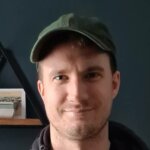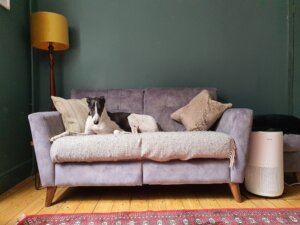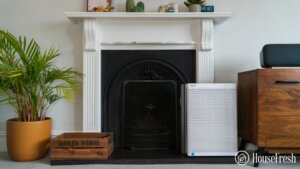Most people don’t consider the importance of air quality in their homes.
Poor air quality can lead to serious health concerns when left unchecked. Exposure to substandard indoor air quality can result in dizziness, headaches and fatigue in the short term, all of which can lead to respiratory diseases, cancer, and heart disease in the long term.
While we can check apps to find out about air quality outside, these won’t be able to complete the picture as air quality indoors will differ. According to the EPA, indoor pollution can be 2-5 times worse than outside so monitoring air quality inside is kind of important.
Thankfully, air quality monitors can detect different pollutants in the home thanks to multiple in-built sensors. These sensors detect pollutants by drawing the air in and passing it through a sensor that detects carbon monoxide, carbon dioxide, radon, and more.
You can rest assured that I didn’t just collate this list by looking at best-sellers on Amazon without any actual first-hand experience. I bought each of the devices on this list to test them in my home.
When choosing the best air quality sensors for this list, I chose options that fit different types of monitors:
- Units able to track particulate matter
- Units able to flag the presence of volatile organic compounds (VOCs)
- Smart units with app support that allow users to export data
- Tabletop units you can keep on your desk
- Mountable units you can fix to the wall or ceiling
- Portable units you can carry with you
It is worth mentioning that this list includes air quality monitors we use as part of our air purifier tests:
- For monitoring particles: Purple Air Indoor Sensor
- For monitoring VOCs: Airthings Wave Plus and Qingping Pro
- For monitoring air quality on the go: Qingping Lite and Aranet4
Staff picks: Top air quality monitors
| BEST OVERALL | FOR TIGHT BUDGETS | FOR VOCs & RADON | |
|---|---|---|---|
| PurpleAir Touch Indoor Air Quality Monitor | Qingping Air Monitor Lite | Airthings 2930 Wave Plus | |
 |  |  | |
| Pro | Excellent for data gathering | Excellent value for money | Multiple sensors in one |
| Con | It is not pretty at all | It switches off automatically after 30 minutes | The app needs to be within range to function |
| Dimensions | 4.25 in x 3 in x 2.25 in (108 mm x 67 mm x 57 mm) | 2.52 x 1.81 x 2.17 inches (6.4 x 4.6 x 5.5 cm) | 4.75 x 4.75 x 1.4 in (12 x 12 x 3.5 cm) |
| Price | $209.00 | $134.99 | $179.99 |
Last update on 2024-04-22 / Affiliate links / Images from Amazon Product Advertising API
Keep reading to learn more about our top three favorite air quality sensors and to discover other monitors that are excellent as well.
1. Best portable monitor: Qingping Air Monitor Lite
There used to be a time when the only air quality monitors you could buy were so inaccurate they were useless. This drove DIY and hobbyists to build their own sensors, but otherwise, you had to spend a lot of money to get something that worked. Luckily, we now have the Qingping Lite, which costs less than $99 and is the perfect air quality monitor.

This air quality monitor can detect PM2.5, PM10, humidity, temperature, and CO2. It’s great to see a CO2 sensor at this price point, as you often need to spend at least $50 to buy a single device that only detects CO2. It has a 4-6 hours battery, so it doesn’t need to be plugged in. Compared with larger, more expensive sensors, it was just as quick to detect pollutants.
What we really like
What we think could be better

Unlike the other portable air quality monitors I have tested in the past, you still get access to the raw data over time as you do with the Purple Air plugged-in monitors. The Qingping app also allows you to export and view data in real-time.
SPECS & FEATURES
| HouseFresh rating: | ★★★★★ |
|---|---|
| Air quality factors detected: | PM2.5, PM10, CO2, temperature and humidity |
| Battery type: | Rechargeable Lithium Battery (USB-C cable supplied) |
| Battery life: | 4 – 6 hours |
| Mounting type: | Table top |
| Dimensions (in inches / in cm): | 2.52 x 1.81 x 2.17 inches (6.4 x 4.6 x 5.5 cm) |
| Weight (in pounds / in kg): | 0.31 lbs (143 g) |
2. Best for testing and data gathering: PurpleAir Touch Indoor Air Quality Monitor
The Purple Air Indoor Sensor is unlikely to win design awards as it looks like a 3d printed block with a sensor stuck in the middle BUT it is our favorite air quality monitor here at HouseFresh due to the sensor’s quality and smart features.

This is the same sensor we use when performing our hands-on air purifier tests, as it allows us to track PM1, PM2.5, and PM10 every few seconds. What I love about this unit and why we use it for our testing is that it allows you to easily export data to make air quality graphs over time, which is perfect for our particular use case. Below is the data we exported from our Purple air indoor sensor when we tested the Blueair Blue Pure 211+:
What we really like
What we think could be better
You also have the choice to share this with the Purple Air community, which makes this the world’s most community-supported air quality sensor. We used this data source when publishing our study on the world’s best towns and cities for air pollution.
SPECS & FEATURES
| HouseFresh rating: | ★★★★★ |
|---|---|
| Air quality factors detected: | PM2.5, PM10, CO2, pressure, temperature, humidity and gas |
| Power requirements: | 5V USB Micro, 0.18A continuous, 600mA peak |
| WiFi: | Yes |
| Mounting type: | Table top |
| Dimensions (in inches / in cm): | 4.25 in x 3 in x 2.25 in (108 mm x 67 mm x 57 mm) |
| Weight (in pounds / in kg): | 0.31 lbs (143 g) |
3. Best sensor for VOC and radon detection: Airthings 2930 Wave Plus
The Airthings 2930 Wave Plus is an indoor air quality monitor with radon detection and it is currently our top choice for the best radon detector.

What we really like
What we think could be better
It is a smart, battery-operated unit with sensors that continually monitor humidity, temperature, air pressure, CO2, and VOCs. Since almost 90% of our time is spent indoors, and considering that the air inside your home is often two to five times worse than the outside air, a continuous air quality monitoring system is a good idea.

SPECS & FEATURES
| HouseFresh Rating: | ★★★★★ |
|---|---|
| Air quality factors detected: | Radon, airborne chemicals (VOCs), carbon dioxide (CO2), humidity, temperature, air pressure |
| Power requirements: | 2 AA batteries required (included) |
| Warranty: | 5-year extended warranty |
| Mounting type: | Table top |
| Dimensions (in inches / in cm): | 4.75 in x 4.75 in x 1.4 in (12.06 x 12.06 x .55 cm) |
| Weight (in pounds / in kg): | 0.48 lbs (222 g) |
4. Qingping Air Quality Monitor Pro
A good-looking unit with an even brighter screen than its smaller brother model, the QingPing Lite. Compared to the QP lite, the Qingping Air Pro can detect VOCs, which is rare as VOC sensors are more expensive and are hardly included in budget air quality monitors.
QP Pro is available in black or white, and it is still a small monitor in size. Yet, despite its size, it is a mighty and accurate device.
The 3.1” high-resolution touch screen has an adjustable brightness level and incorporates a retina IPS display with a large viewing angle and high contrast. The “home” screen shows the current time, outside temperature and air quality for your location, the date and the weather.
What we really like
What we think could be better
Air quality readings such as PM2.5, VOCs, CO2, temperature, and relative humidity levels are displayed with color-coded bars below the numbers to show the air quality inside. The included instruction manual is easy to read, explaining how to view different screens, expand any readings, and various other functions needed to take advantage of this top-of-the-range air quality monitor.

Installing the QingPing app on your smartphone allows you to monitor all the detected metrics as long as the device is connected to 2.4GHz Wi-Fi. It is important to note that the device will not connect to a 5GHz Wi-Fi router but may work if the router has a combo 2.4GHz/5GHz output signal.
SPECS & FEATURES
| HouseFresh rating: | ★★★★★ |
|---|---|
| Air quality factors detected: | PM2.5, VOCs, CO2, temperature and relative humidity |
| Power requirements: | Corded electric or battery-powered |
| WiFi: | Yes |
| Mounting type: | Table top |
| Dimensions (in inches / in cm): | 3.35 x 2.69 x 3.4 in (8.5 x 7.5 x 8.6 cm) |
| Weight (in pounds / in kg): | 0.48 lbs (222 g) |
5. Aranet4 Sensor
Since COVID-19, there has been a dramatic increase in the amount of research on how to reduce the risk of viral infection in a close space, and one of the big things to come out was how you could use CO2 levels to know the ventilation level of a room and potential issues with its IAQ.
If this is a concern of yours, then you will be happy to learn that the Aranet4 shows CO2 levels at regular intervals, which is a great indicator of the current ventilation levels of a room.

What we really like
What we think could be better
It has a battery that lasts for years, depending on the mode you choose and a screen you can see thanks to e-ink technology easily. Another great feature of the Aranet4 is the accompanying app, which allows you to see even more data.

SPECS & FEATURES
| HouseFresh Rating: | ★★★☆☆ |
|---|---|
| Air quality factors detected: | CO2 |
| Sensor used: | Non-dispersive infrared sensor |
| Power requirements: | Battery-powered |
| Battery life: | 4.8 years using alkaline battery or 7 years using lithium battery |
| Mounting type: | Table top |
| Dimensions (in inches / in cm): | 2.76 x 2.76 x 0.94 in (7.01 x 7.01 x 2.38 cm) |
| Weight (in pounds / in kg): | 0.23 lbs (104 g) |
6. Huma-i (HI-150)
The Huma-I (HI-150) air quality monitor allows you to monitor the surrounding air quality at the touch of a button. The built-in fan efficiently draws in the air around you, giving real-time results. This monitor provides all the data necessary to understand your home’s air quality through its advanced sensors.

The Huma-I (HI-150) air quality monitor is a completely portable unit, measuring 1.6 x 3.6 x 1.5 inches, weighing approximately 2.1 ounces and is touted as one of the best air quality monitors money can buy. This monitor gives the user a choice between viewing the air quality as a graph or as icons. The icon mode shows you a “smiley face” when the air quality is good, and a “masked face” when the air quality is bad. When used in graph mode, the information provided is more detailed, displaying accurate levels of each measurement.
What we really like
What we think could be better
SPECS & FEATURES
| HouseFresh Rating: | ★★★☆☆ |
|---|---|
| Air quality factors detected: | CO2, VOC, PM2.5 & PM10, Temperature and Humidity |
| Power requirements: | Rechargeable battery |
| Battery life: | Approximately one hour |
| Mounting type: | Table top |
| Dimensions (in inches / in cm): | 3.58 x 1.61 x 1.46 in (9.09 x 4.08 x 3.70 cm) |
| Weight (in pounds / in kg): | 0.13 lbs (58 g) |
Common questions about air quality monitors
The air quality sensors available to consumers estimate particulate matter or gaseous pollution in the air, often based on a reading of a different but easier-to-measure substance related to the pollutant. For instance, a sensor may be designed to measure the amount of light that particulate matter scatters, which, more often than not, increases as the levels of pollution rise. These results are then interpreted by the device and shown on a scale of low to high, sometimes with associated colored bars or LEDs.
The most basic air quality monitor is one you probably already have in your home—a smoke detector, which uses a binary scale and signals whether smoke is present.
Air quality is measured by the EPA using the U.S. Air Quality Index (AQI), and it has six categories corresponding to different levels of health concerns. Each of the six categories has its own color to make it easier for the public to know if the air quality is approaching unhealthy levels. The colors and categories are:
- Green – Good
- Yellow – Moderate
- Orange – Unhealthy for sensitive groups
- Red – Unhealthy
- Purple – Very unhealthy
- Maroon – Hazardous
According to the CDC, “The EPA has identified six pollutants as “criteria” air pollutants”. These six air pollutants are:
1. Carbon Monoxide. Breathing in high levels of CO can cause confusion, unconsciousness, and death.
2. Lead. Lead in the air may have an adverse effect on the nervous system, kidneys, immune system, and cardiovascular system.
3. Nitrogen Oxides (NO2). Breathing air with high levels of NO2 can lead to respiratory problems such as asthma and can become severe.
4. Ozone. Increased ozone levels can cause coughing, damage your airways, and make the lungs more vulnerable to infections.
5. Particulate Matter. This pollutant contains solids or liquid droplets so small they can only be seen under a microscope and if inhaled, can cause serious health problems, getting into your lungs, and even into your bloodstream.
6. Sulfur Dioxide (SO2). Exposure to SO2 can cause harm to your respiratory system and make it difficult to breathe. Asthmatics and young children are at particular risk.
You’ve probably heard that the air inside your home can contain up to five times more pollutants than the outside air. The only way to accurately monitor the air quality in your home is to invest in a suitable quality air quality monitoring device.
An indoor air quality monitor, by definition, does precisely what the name implies: it monitors the quality of the air inside your home, continuously or periodically, depending on the type of monitor.
If you are concerned about the air quality in your home, get a monitor that tests for nearly all the pollutants found indoors. Almost all monitors test for particulate matter, chemical pollutants, and humidity. Some will test for radon, carbon monoxide, carbon dioxide, temperature, and formaldehyde. The better monitors will sound an alarm if the levels of any of the test results go above a designated level.
It all depends on the technology the sensors use, the type of sensor, and lastly, the incorporated display method. Many middle- to high-end air purifiers have at least one integrated sensor. The most commonly found sensor is a PM2.5 sensor, capable of detecting particle matter up to 2.5 micrometers. They are normally the cheapest to manufacture and provide only basic readings and results. PM2.5 sensors found in air purifiers mostly use infrared technology, and while they do what they are supposed to do, the measurements are not very accurate. On the other hand, laser beam technology gives more precise air quality readings.
The display method used by the air purifier to show the quality of the air is also an important factor in determining the accuracy of the sensors. Most of them use a color scale to show the quality of the air—green for good, up to red for bad—which may look appealing, but it doesn’t tell you much. A display that shows the air quality index as a number, or a series of numbers, is more accurate.
PM2.5 is the measurement given to fine particulate matter (PM) with a thickness of fewer than 2.5 micrometers. To put that number in perspective, a grain of sand has a diameter of 90 micrometers, and a human hair measures 50-70 micrometers.
A PM2.5 sensor works by counting these fine particles suspended in the air. As air is sucked into an air quality monitoring device, particles in the air stream pass through a laser beam, which causes the light to diffract. The diffracted light will land on the sensor, placed at a right angle to the laser beam. The changes in the light intensity that the sensor picks up mean that individual particles can be counted.
VOC is an acronym for Volatile Organic Compounds and is an extremely broad classification of carbon-based chemicals. Consumer-related devices with integrated VOC sensors have become more and more available in the past few years, but they are relatively low-cost sensors that can only give a general reading as to the total amount of VOCs in the air and cannot pinpoint with any accuracy exactly what VOC it is detecting. They cannot differentiate between VOCs that are harmful and those that are not. There are some sensors on the market specifically designed to detect particular VOCs. For example, you can get a sensor that will detect formaldehyde, one for Carbon Monoxide, another for Radon, and some high-end devices have multiple sensors built-in to cover all major VOC detections with some degree of accuracy. Still, they tend to be a bit pricey.
The PurpleAir air quality sensors have been tested by various consumers nationwide and have received glowing reviews regarding their accuracy. One reason for the high praise is that they are industrial-grade sensors but priced at a level affordable to homeowners. They don’t come with a smartphone app, but their data is vast, and they can be integrated into smart home devices.
These sensors employ different techniques to evaluate the microscopic particles in the air, and although it is not as reliable as regulatory-grade monitors, Lawrence Berkeley Lab tested them and found that the PurpleAir sensor performed better than most.
Depending on your smartphone’s operating system, two of the best air quality apps are:
- For Android users, the IQAir AirVisual app gives you historical, real-time, and forecast air quality data for your area. It provides live information on the six “criteria” for air pollutants, with health recommendations.
- For Apple users, then the Air Quality Reader is an excellent choice. With this app, you can switch between the air quality data from the EPA and the air quality index readings provided by PurpleAir on their website.
Do air quality sensors really work?
The short answer is, yes they do. In most cases, you should consider a monitor that can detect the air pollution you consider the highest risk to your home and family.
Available to the consumer, air quality monitors can be a single-pollutant sensor, such as radon or carbon monoxide, or a sensor that will detect multiple pollutants, like VOCs, humidity, temperature, formaldehyde, as well as radon, carbon dioxide, and particle matter (PM2.5).
If you buy an air quality monitor, you should consider a monitor that can detect several toxic gases, not just one. Look carefully at the specifications of the monitor, and read any sample results that are provided. Check whether any of the monitors need calibration regularly to produce accurate results.
Last update on 2024-04-22 / Affiliate links / Images from Amazon Product Advertising API








